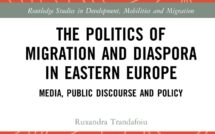

In this section of Campus, EuropeNow features a selection of scholarly articles and books on topics pertinent to the teaching of Europe or teaching in Europe that were published within the last 5 years. This dynamic bibliography, with bimonthly installments, seeks to highlight both pedagogy research and critical analyses of debates taking place in higher education in and about Europe.
1. Teaching the Arab-Israeli Conflict
Edited by Rachel S. Harris
At Wayne State University Press
Abstract: The Arab-Israeli conflict has become a touchstone of international politics and a flash point on college campuses. And yet, how do faculty teach such a contentious topic in class? Taught not only in international relations, peace and conflict resolution, politics and history, and Israel and Middle Eastern studies courses but also in literature, sociology, urban planning, law, cinema, fine art, and business—the subject guarantees wide interest among students. Faculty are challenged to deal with the subject’s complexity and the sensitive dynamics it creates. The result is anxiety as they approach the task and a need for guidance. Teaching the Arab-Israeli Conflict edited by Rachel S. Harris is the first book designed to meet this need. Teaching the Arab-Israeli Conflict brings together thirty-nine essays from experienced educators who reflect on the challenges of engaging students in college classrooms. Divided into seven sections, these personal essays cover a broad range of institutional and geographical settings, as well as a wide number of academic disciplines. Some of the topics include using graphic novels and memoirs to wrestle with the complexities of Israel/Palestine, the perils of misreading in the creative writing classroom as border crossing, teaching competing narratives through film, using food to teach the Arab-Israeli conflict, and teaching the subject in the community college classroom. Each essay includes suggestions for class activities, resources, and approaches to effective teaching. Whether planning a new course or searching for new teaching ideas, this collection is an indispensable compendium for anyone teaching the Arab-Israeli conflict.
2. Memorialization, Reconciliation, and Reflection: Teaching the Aftermaths of Genocide in Postwar Europe and Rwanda
By Laura J. Hilton
In The History Teacher
Abstract: The aim of this article is to examine the frameworks that educators use, especially how we conclude our teaching and learning about genocide, and to suggest readings and other sources for use. The narrative arc that educators establish by choosing where to begin and where to end is a powerful indicator of their course goals and teaching rationales. When selected deliberately and thoughtfully, these shape student perception of the events under discussion, often in subtle yet influential ways. While, certainly, each genocide has multiple common starting points (the rise to power of a dictator, the influence of decolonization, the increased tension between ethnic groups), the choice of where to end discussions or courses is seldom discussed. How do educators and students define the “end” of a genocide? What are the implications of ending a course on the Holocaust with the liberation of camps such as Dachau or Buchenwald? How much do educators cover what happens after the genocide is over, when the widespread violence and persecution has ceased? What were the key elements involved in contemporaries processing and negotiating the aftermath—for example, the long process of return for the internally displaced and/or refugee populations from Rwanda or the extended time in displaced persons camps in central Europe for Jews following the Holocaust? How did people at that time grapple with, define, and describe the events that occurred? How have these definitions and descriptions shifted since then? By posing thoughtful questions such as these, educators can encourage students to push beyond the oversimplified assertions of “never again” and/or that we would take action to stop it from occurring.
3. A “Pedagogy of Discomfort”? Experiential Learning and Conflict Analysis in Israel-Palestine
By Naomi Head
In International Studies Perspectives
Abstract: A “pedagogy of discomfort” (Boler 1999) recognizes the degree to which epistemology, emotions, and ethics are closely entwined both within and beyond our classrooms shaping who, what, where, why, and when we can see. It recognizes not only the intellectual and cognitive focus of education but also its embodied and affective dimensions. A pedagogy of discomfort which engages with the historically, politically, and ideologically contested and the emotionally invested subject of Israel/Palestine offers one way to engage in the teaching and learning of conflict analysis, and to support the development of active and critical student-citizens. This article suggests that experiential learning can support the development of pedagogical discomfort and explores this in the context of the Olive Tree Initiative, a narrative-based and experiential learning program for undergraduate politics and international relations students that focuses on Israel/Palestine. Drawing on student testimony, this article explores the ways in which the program plays a role in challenging dominant social, political, and emotional beliefs in order to create possibilities for individual and social transformation. It also reflects on some of the challenges and limitations posed by this approach, and engages with questions of emotions, vulnerability, and ambiguity in and beyond the classroom.
4. Teaching Palestine-Israel: A Pedagogy of Delay and Suspension
By Daniel A. Segal
In Middle East Studies
Abstract: Teaching about the ongoing crisis of Palestine and Israel poses distinctive challenges. In my case, these challenges, and the ways I address them, are specific to my being (i) a faculty member at a small liberal arts college and (ii) a teacher whose scholarly judgment is that the Israeli state is responsible for grievous oppression of Palestinians. The first of these conditions gives me a degree of flexibility and the opportunity to engage students in “serious play” not equally available to faculty teaching at institutions with larger class sizes and more intrusive top-down audit regimes. The second condition poses the problem of how can I teach what I judge to be truthful about Israel and Palestine without imposing my views on students, that is, through genuine teaching rather than indoctrination.
5. Teaching about the Russian Invasion of Ukraine in US History Classrooms
By Chelsea Gibson
In Nursing Clio
Abstract: Teachers are undoubtedly scrambling to address the Russian-Ukrainian war in their classrooms, and many probably feel underprepared to talk about a war in an area about which they may have little expertise. One of my guiding pedagogical principles is that, in a history classroom, providing context is often more powerful than an exhaustive recitation of facts. That is, you can do a lot this semester to address the war in Ukraine without late-night deep dives into the history of Kievan Rus. There are of course many, many experts providing us with essential facts about the war – and I’m grateful to them. However, there are ways to expand upon the topics already included in your modern US survey (whether at the postsecondary or high school level) to help students better grasp some key elements of the conflict.
Photo: Shutterstock | Hradec Kralove, Czech Republic, public university library.
Published on April 15, 2024.




